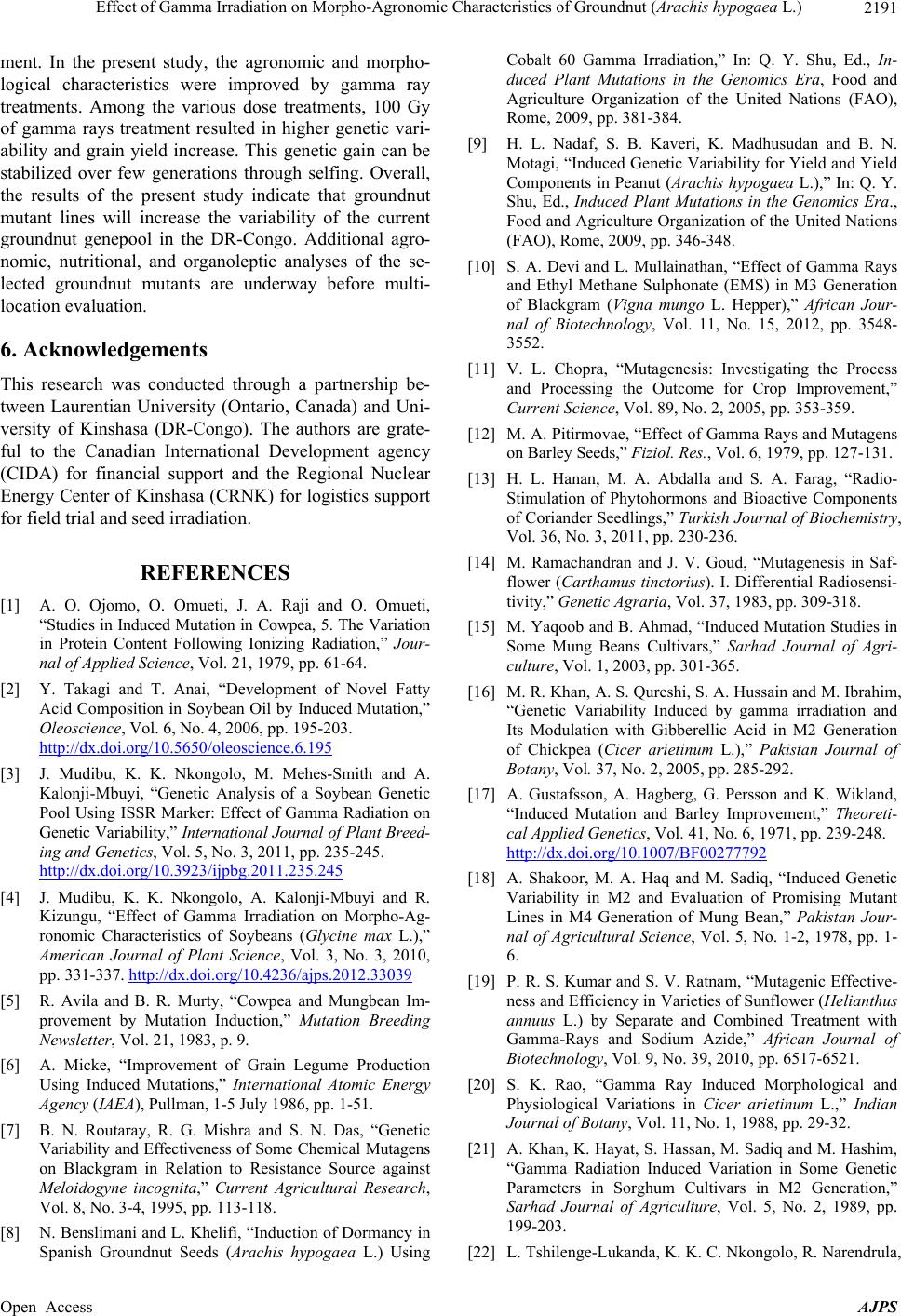
Effect of Gamma Irradiation on Morpho-Agronomic Characteristics of Groundnut (Arachis hypogaea L.) 2191
ment. In the present study, the agronomic and morpho-
logical characteristics were improved by gamma ray
treatments. Among the various dose treatments, 100 Gy
of gamma rays treatment resulted in higher genetic vari-
ability and grain yield increase. This genetic gain can be
stabilized over few generations through selfing. Overall,
the results of the present study indicate that groundnut
mutant lines will increase the variability of the current
groundnut genepool in the DR-Congo. Additional agro-
nomic, nutritional, and organoleptic analyses of the se-
lected groundnut mutants are underway before multi-
location evaluation.
6. Acknowledgements
This research was conducted through a partnership be-
tween Laurentian University (Ontario, Canada) and Uni-
versity of Kinshasa (DR-Congo). The authors are grate-
ful to the Canadian International Development agency
(CIDA) for financial support and the Regional Nuclear
Energy Center of Kinshasa (CRNK) for logistics support
for field trial and seed irradiation.
REFERENCES
[1] A. O. Ojomo, O. Omueti, J. A. Raji and O. Omueti,
“Studies in Induced Mutation in Cowpea, 5. The Variation
in Protein Content Following Ionizing Radiation,” Jour-
nal of Applied Science, Vol. 21, 1979, pp. 61-64.
[2] Y. Takagi and T. Anai, “Development of Novel Fatty
Acid Composition in Soybean Oil by Induced Mutation,”
Oleoscience, Vol. 6, No. 4, 2006, pp. 195-203.
http://dx.doi.org/10.5650/oleoscience.6.195
[3] J. Mudibu, K. K. Nkongolo, M. Mehes-Smith and A.
Kalonji-Mbuyi, “Genetic Analysis of a Soybean Genetic
Pool Using ISSR Marker: Effect of Gamma Radiation on
Genetic Variability,” International Journal of Pla nt Breed-
ing and Genetics, Vol. 5, No. 3, 2011, pp. 235-245.
http://dx.doi.org/10.3923/ijpbg.2011.235.245
[4] J. Mudibu, K. K. Nkongolo, A. Kalonji-Mbuyi and R.
Kizungu, “Effect of Gamma Irradiation on Morpho-Ag-
ronomic Characteristics of Soybeans (Glycine max L.),”
American Journal of Plant Science, Vol. 3, No. 3, 2010,
pp. 331-337. http://dx.doi.org/10.4236/ajps.2012.33039
[5] R. Avila and B. R. Murty, “Cowpea and Mungbean Im-
provement by Mutation Induction,” Mutation Breeding
Newsletter, Vol. 21, 1983, p. 9.
[6] A. Micke, “Improvement of Grain Legume Production
Using Induced Mutations,” International Atomic Energy
Agency (IAEA), Pullman, 1-5 July 1986, pp. 1-51.
[7] B. N. Routaray, R. G. Mishra and S. N. Das, “Genetic
Variability and Effectiveness of Some Chemical Mutagens
on Blackgram in Relation to Resistance Source against
Meloidogyne incognita,” Current Agricultural Research,
Vol. 8, No. 3-4, 1995, pp. 113-118.
[8] N. Benslimani and L. Khelifi, “Induction of Dormancy in
Spanish Groundnut Seeds (Arachis hypogaea L.) Using
Cobalt 60 Gamma Irradiation,” In: Q. Y. Shu, Ed., In-
duced Plant Mutations in the Genomics Era, Food and
Agriculture Organization of the United Nations (FAO),
Rome, 2009, pp. 381-384.
[9] H. L. Nadaf, S. B. Kaveri, K. Madhusudan and B. N.
Motagi, “Induced Genetic Variability for Yield and Yield
Components in Peanut (Arachis hypogaea L.),” In: Q. Y.
Shu, Ed., Induced Plant Mutations in the Genomics Era.,
Food and Agriculture Organization of the United Nations
(FAO), Rome, 2009, pp. 346-348.
[10] S. A. Devi and L. Mullainathan, “Effect of Gamma Rays
and Ethyl Methane Sulphonate (EMS) in M3 Generation
of Blackgram (Vigna mungo L. Hepper),” African Jour-
nal of Biotechnology, Vol. 11, No. 15, 2012, pp. 3548-
3552.
[11] V. L. Chopra, “Mutagenesis: Investigating the Process
and Processing the Outcome for Crop Improvement,”
Current Science, Vol. 89, No. 2, 2005, pp. 353-359.
[12] M. A. Pitirmovae, “Effect of Gamma Rays and Mutagens
on Barley Seeds,” Fiziol. Res., Vol. 6, 1979, pp. 127-131.
[13] H. L. Hanan, M. A. Abdalla and S. A. Farag, “Radio-
Stimulation of Phytohormons and Bioactive Components
of Coriander Seedlings,” Turkish Journal of Biochemistry,
Vol. 36, No. 3, 2011, pp. 230-236.
[14] M. Ramachandran and J. V. Goud, “Mutagenesis in Saf-
flower (Carthamus tinctorius). I. Differential Radiosensi-
tivity,” Genetic Agraria, Vol. 37, 1983, pp. 309-318.
[15] M. Yaqoob and B. Ahmad, “Induced Mutation Studies in
Some Mung Beans Cultivars,” Sarhad Journal of Agri-
culture, Vol. 1, 2003, pp. 301-365.
[16] M. R. Khan, A. S. Qureshi, S. A. Hussain and M. Ibrahim,
“Genetic Variability Induced by gamma irradiation and
Its Modulation with Gibberellic Acid in M2 Generation
of Chickpea (Cicer arietinum L.),” Pakistan Journal of
Botany, Vol. 37, No. 2, 2005, pp. 285-292.
[17] A. Gustafsson, A. Hagberg, G. Persson and K. Wikland,
“Induced Mutation and Barley Improvement,” Theoreti-
cal Applied Genetics, Vol. 41, No. 6, 1971, pp. 239-248.
http://dx.doi.org/10.1007/BF00277792
[18] A. Shakoor, M. A. Haq and M. Sadiq, “Induced Genetic
Variability in M2 and Evaluation of Promising Mutant
Lines in M4 Generation of Mung Bean,” Pakistan Jour-
nal of Agricultural Science, Vol. 5, No. 1-2, 1978, pp. 1-
6.
[19] P. R. S. Kumar and S. V. Ratnam, “Mutagenic Effective-
ness and Efficiency in Varieties of Sunflower (Helianthus
annuus L.) by Separate and Combined Treatment with
Gamma-Rays and Sodium Azide,” African Journal of
Biotechnology, Vol. 9, No. 39, 2010, pp. 6517-6521.
[20] S. K. Rao, “Gamma Ray Induced Morphological and
Physiological Variations in Cicer arietinum L.,” Indian
Journal of Botany, Vol. 11, No. 1, 1988, pp. 29-32.
[21] A. Khan, K. Hayat, S. Hassan, M. Sadiq and M. Hashim,
“Gamma Radiation Induced Variation in Some Genetic
Parameters in Sorghum Cultivars in M2 Generation,”
Sarhad Journal of Agriculture, Vol. 5, No. 2, 1989, pp.
199-203.
[22] L. Tshilenge-Lukanda, K. K. C. Nkongolo, R. Narendrula,
Open Access AJPS